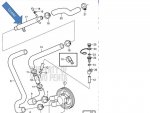herring627
Cadet
- Joined
- Mar 9, 2018
- Messages
- 24
Hey guys, you know how sometimes you want to just give up, well I am filling like that right now. This is when I turn to you all for help. My 2002 VP 5.0 GL-C overheated terribly a couple months ago. Impeller was shredded and thermostat ugly. Both are replaced along with manifolds yet it continues to overheat (buzzer goes off around 190 degrees).
The Volvo Penta Overheat Diagnosis (see link below) guide is informative and extensive but at some places gets a bit too technical for a newbie. So my question is - what do I do next? I read over and over that if their is air getting into the engine it will cause overheating. Would you agree? Where would I turn to next?
1. Do I do a "clear hose test" to determine whether air or water is entering or exiting the raw water pump?
2. Do I perform this same to est at the thermostat?
3. Do I perform a "cylinder leak down test"?
4. Do I perform the acetone leak test for the risers (viz. Don S. test)?
And then there are other things to check like the ECMs for DTCs? Should I go this route first? Other things to consider - there is likely water in my oil (silver in color from dipstick, but only when engine is hot, otherwise dark brown) and likely prior water intrusion in engine (see pic.) So thank you for giving this post a look at and adding your sage advice below. In the end, say I buy the parts, identify a leak, I wonder if I will proceed to fix or take it into the mechanic. Time will tell.
In the end, say I buy the parts, identify a leak, I wonder if I will proceed to fix or take it into the mechanic. Time will tell.
The Volvo Penta Overheat Diagnosis (see link below) guide is informative and extensive but at some places gets a bit too technical for a newbie. So my question is - what do I do next? I read over and over that if their is air getting into the engine it will cause overheating. Would you agree? Where would I turn to next?
1. Do I do a "clear hose test" to determine whether air or water is entering or exiting the raw water pump?
2. Do I perform this same to est at the thermostat?
3. Do I perform a "cylinder leak down test"?
4. Do I perform the acetone leak test for the risers (viz. Don S. test)?
And then there are other things to check like the ECMs for DTCs? Should I go this route first? Other things to consider - there is likely water in my oil (silver in color from dipstick, but only when engine is hot, otherwise dark brown) and likely prior water intrusion in engine (see pic.) So thank you for giving this post a look at and adding your sage advice below.
Attachments
Last edited by a moderator:























